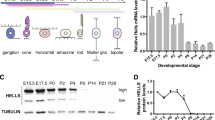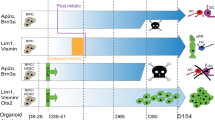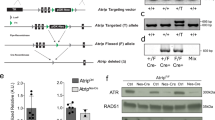Abstract
Synthetic lethality is a promising strategy for specific targeting of cancer cells that carry mutations that are absent in normal cells1. This approach may help overcome the challenge associated with targeting dysfunctional tumour suppressors, such as p53 and Rb (refs 1, 2). Here we show that Dicer1 targeting prevents retinoblastoma formation in mice by synthetic lethality with combined inactivation of p53 and Rb. Although Dicer1 functions as a haploinsufficient tumour suppressor, its complete loss of function is selected against during tumorigenesis3,4,5. We show that Dicer1 deficiency is tolerated in Rb-deficient retinal progenitor cells harbouring an intact p53 pathway, but not in the absence of p53. This synthetic lethality is mediated by the oncogenic miR-17–92 cluster because its deletion phenocopies Dicer1 loss in this context. miR-17–92 inactivation suppresses retinoblastoma formation in mice and co-silencing of miR-17/20a and p53 cooperatively decreases the viability of human retinoblastoma cells. These data provide an explanation for the selective pressure against loss of Dicer1 during tumorigenesis and a proof-of-concept that targeting miRNAs may potentially represent a general approach for synthetic lethal targeting of cancer cells that harbour specific cancer-inducing genotypes.
This is a preview of subscription content, access via your institution
Access options
Subscribe to this journal
Receive 12 print issues and online access
$209.00 per year
only $17.42 per issue
Buy this article
- Purchase on Springer Link
- Instant access to full article PDF
Prices may be subject to local taxes which are calculated during checkout





Similar content being viewed by others
Accession codes
References
Kaelin, W. G. Jr The concept of synthetic lethality in the context of anticancer therapy. Nat. Rev. Cancer 5, 689–698 (2005).
Hartwell, L. H., Szankasi, P., Roberts, C. J., Murray, A. W. & Friend, S. H. Integrating genetic approaches into the discovery of anticancer drugs. Science 278, 1064–1068 (1997).
Kumar, M. S. et al. Dicer1 functions as a haploinsufficient tumor suppressor. Genes Dev. 23, 2700–2704 (2009).
Lambertz, I. et al. Monoallelic but not biallelic loss of Dicer1 promotes tumorigenesis in vivo. Cell Death Differ. 17, 633–641 (2010).
Arrate, M. P. et al. MicroRNA biogenesis is required for Myc-Induced B-Cell lymphoma development and survival. Cancer Res. 15, 6083–92 (2010).
Toledo, F. & Wahl, G. M. Regulating the p53 pathway: in vitro hypotheses, in vivo veritas. Nat. Rev. Cancer 6, 909–923 (2006).
Laurie, N. A. et al. Inactivation of the p53 pathway in retinoblastoma. Nature 444, 61–66 (2006).
Xu, X. L. et al. Retinoblastoma has properties of a cone precursor tumor and depends upon cone-specific MDM2 signaling. Cell 137, 1018–1031 (2009).
Conkrite, K., Sundby, M., Mu, D., Mukai, S. & Macpherson, D. Cooperationbetween Rb and Arf in suppressing mouse retinoblastoma. J. Clin. Invest. 122, 1726–1733 (2012).
Karube, Y. et al. Reduced expression of Dicer associated with poor prognosis in lung cancer patients. Cancer Sci. 96, 111–115 (2005).
Kumar, M. S., Lu, J., Mercer, K. L., Golub, T. R. & Jacks, T. Impaired microRNA processing enhances cellular transformation and tumorigenesis. Nat. Genet. 39, 673–677 (2007).
Melo, S. A. et al. A TARBP2 mutation in human cancer impairs microRNA processing and DICER1 function. Nat. Genet. 41, 365–370 (2009).
Pampalakis, G., Diamandis, E. P., Katsaros, D. & Sotiropoulou, G. Down-regulation of dicer expression in ovarian cancer tissues. Clin. Biochem. 43, 324–327 (2009).
Hill, D. A. et al. DICER1 mutations in familial pleuropulmonary blastoma. Science 325, 965 (2009).
Donovan, S. L. & Dyer, M. A. Developmental defects in Rb-deficient retinae. Vision Res. 44, 3323–3333 (2004).
Rowan, S. & Cepko, C. L. Genetic analysis of the homeodomain transcription factor Chx10 in the retina using a novel multifunctional BAC transgenic mouse reporter. Dev. Biol. 271, 388–402 (2004).
Damiani, D. et al. Dicer inactivation leads to progressive functional and structural degeneration of the mouse retina. J. Neurosci. 28, 4878–4887 (2008).
Mudhasani, R. et al. Loss of miRNA biogenesis induces p19Arf-p53 signaling and senescence in primary cells. J. Cell Biol. 181, 1055–1063 (2008).
Donovan, S. L., Schweers, B., Martins, R., Johnson, D. & Dyer, M. A. Compensation by tumor suppressor genes during retinal development in mice and humans. BMC Biol. 4, 14 (2006) http://dx.doi.org/10.1186/1741-7007-4-14.
Zhang, J., Schweers, B. & Dyer, M. A. The first knockout mouse model of retinoblastoma. Cell Cycle 3, 952–959 (2004).
Brennan, R. C. et al. Targeting the p53 pathway in retinoblastoma with subconjunctival Nutlin-3a. Cancer Res. 71, 4205–4213 (2011).
Van Haaften, G. & Agami, R. Tumorigenicity of the miR-17-92 cluster distilled. Genes. Dev. 24, 1–4 (2010).
Aguda, B. D., Kim, Y., Piper-Hunter, M. G., Friedman, A. & Marsh, C. B. MicroRNA regulation of a cancer network: consequences of the feedback loops involving miR-17-92, E2F, and Myc. Proc. Natl Acad. Sci. USA 105, 19678–19683 (2008).
Yan, H. L. et al. Repression of the miR-17-92 cluster by p53 has an important function in hypoxia-induced apoptosis. EMBO J. 28, 2719–2732 (2009).
Conkrite, K. et al. miR-17–92 cooperates with RB pathway mutations to promote retinoblastoma. Genes Dev. 25, 1734–1745 (2011).
Ventura, A. et al. Targeted deletion reveals essential and overlappingfunctions of the miR-17 through 92 family of miRNA clusters. Cell 132, 875–886 (2008).
Brough, R., Frankum, J. R., Costa-Cabral, S. & Lord, C. J. Ashworth, (ed.) Searching for synthetic lethality in cancer. Curr. Opin. Genet. Dev. 21, 34–41 (2011).
Yi, R. et al. Morphogenesis in skin is governed by discrete sets of differentially expressed microRNAs. Nat. Genet. 38, 356–362 (2006).
Singh, M. K., Lu, M. M., Massera, D. & Epstein, J. A. MicroRNA-processing enzyme Dicer is required in epicardium for coronary vasculature development. J. Biol. Chem. 286, 41036–41045 (2011).
O’Rourke, J. R. et al. Essential role for Dicer during skeletal muscle development. Dev. Biol. 311, 359–368 (2007).
Pinter, R. & Hindges, R. Perturbations of microRNA function in mouse dicer mutants produce retinal defects and lead to aberrant axon pathfinding at the optic chiasm. PLoS One 5, e10021 (2010).
Georgi, S. A. & Reh, T. A. Dicer is required for the transition from early to late progenitor state in the developing mouse retina. J. Neurosci. 30, 4048–4061 (2010).
Sangwan, M. et al. Established and new mouse models reveal E2f1 and Cdk2 dependency of retinoblastoma, and expose effective strategies to block tumor initiation. Oncogenehttp://dx.doi.org/10.1038/onc.2011.654 [Epub ahead of print] (2012).
Mestdagh, P. et al. High-throughput stem-loop RT-qPCR miRNA expression profiling using minute amounts of input RNA. Nucleic Acids Res. 36, e143 (2008).
Mestdagh, P. et al. A novel and universal method for microRNA RT-qPCR data normalization. Gen. Biol. 10, R64 (2009).
Lefever, S. et al. RDML: Structured language and reporting guidelines for real-time quantitative PCR data. Nucleic Acids Res. 37, 2065–2069 (2009).
Lam, S. et al. Role of Mdm4 in drug sensitivity of breast cancer cells. Oncogene 29, 2415–2426.
Acknowledgements
We thank O. Van Goethem, H. Stephan and M. Baumann for excellent technical advice and/or assistance. We thank M. Skipper for helpful comments on the manuscript and G. Hannon (Watson School of Biological Sciences, Cold Spring Harbor Laboratory, USA) for providing the Dicer1 floxed mice. This work was supported in part by FWO, the Belgian Foundation against Cancer (BFK), Geconcerteerde Onderzoek Aangelegenheden (GOA, KULeuven, Belgium) and the German Federal Ministry of Education and Research, BMBF (NGFNplus, ENGINE) as well as the EU (FP7, ONCOMIRS, Contract 201102). This publication reflects only the authors’ views. The commission is not liable for any use that may be made of the information herein.
Author information
Authors and Affiliations
Contributions
D.N. and I.L. performed experimental work, developed the hypothesis, analysed the data and coordinated the project. F.C. and C.K. performed the transfection studies in the human retinoblastoma cells and analysed the data. P.M. performed the miR-profiling experiments and analysed the data. S.J.N. contributed to the design of the miR-inhibition experiments. A.J. generated and characterized the Y79 p53KD cell line. A.S. and J.H.S. provided the human retinoblastoma samples. F.S., J.V., M.A.D., A.S. and J.H.S. discussed the hypothesis and contributed to data interpretation and experimental design. J-C.M. conceived the hypothesis, led the project, interpreted the data and wrote the manuscript.
Corresponding author
Ethics declarations
Competing interests
The authors declare no competing financial interests.
Supplementary information
Supplementary Information
Supplementary Information (PDF 1176 kb)
Supplementary Table 1
Supplementary Information (XLS 80 kb)
Supplementary Table 2
Supplementary Information (XLS 25 kb)
Rights and permissions
About this article
Cite this article
Nittner, D., Lambertz, I., Clermont, F. et al. Synthetic lethality between Rb, p53 and Dicer or miR-17–92 in retinal progenitors suppresses retinoblastoma formation. Nat Cell Biol 14, 958–965 (2012). https://doi.org/10.1038/ncb2556
Received:
Accepted:
Published:
Issue Date:
DOI: https://doi.org/10.1038/ncb2556
This article is cited by
-
Retinoblastoma tumor cell proliferation is negatively associated with an immune gene expression signature and increased immune cells
Laboratory Investigation (2021)
-
Inhibition of miR-1193 leads to synthetic lethality in glioblastoma multiforme cells deficient of DNA-PKcs
Cell Death & Disease (2020)
-
Pineoblastoma segregates into molecular sub-groups with distinct clinico-pathologic features: a Rare Brain Tumor Consortium registry study
Acta Neuropathologica (2020)
-
Expression profiles and prognostic value of miRNAs in retinoblastoma
Journal of Cancer Research and Clinical Oncology (2019)
-
Synthetic lethal therapies for cancer: what’s next after PARP inhibitors?
Nature Reviews Clinical Oncology (2018)



